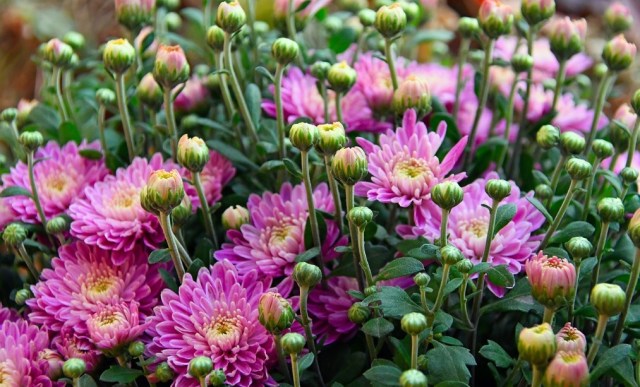Chrysanthemums: Plants with beautiful breathtaking flowers

Image by Marjon Besteman-Horn from Pixabay
Chrysanthemum is known for its beautiful flowers that come in breathtaking colors. They are one of the best addition to the garden. The care is low and requires little attention. If grown under optimum conditions, the plants can be grown easily and adds beauty to the garden.
Quick Details of Chrysanthemums
| Other Common Names | Mum, Chrysanthemum, Garden mum |
| Type | Outdoor flowering plant |
| Maintenance | Low-moderate |
| Flowering | Late summer -fall |
| Light | Bright direct sunlight for at least 6 hours a day. |
| Water | Water them regularly |
| Temperature | Warm climatic conditions. Cannot tolerate extreme heat or cold |
| Soil | Any well draining soil |
| Fertilizer | Fertilizer rich in nitrogen and potassium |
| Habitat | East Asia and Europe |
| Toxicity | Toxic to pets |
| Common Diseases | Leaf spot, powdery mildew, mosaic virus |
| Scientific name | Chrysanthemum indicum |
Chrysanthemums Buying Instructions
- There are so many variety and colors available so buy the plant of your choice.
- Buy a bushy plant with lots of branches.
- Buy Chrysanthemum plant with lots of buds which are not open yet. Do not buy the plant with full of flowers, it may not survive for long.
Overview of Chrysanthemums
One of the most common fall garden flowers belong to the family of Asteraceae and are native to East Asia and Northeast Europe. It is grown in a variety of types and sizes, there are hundreds of varieties available that can provide blooms from late summer through autumn.
They have alternately arranged leaves with dented or sometimes smooth edges separated into leaflets. The inflorescence is mostly compound or occasionally a solitary head. The head is wrapped in layers of phyllaries. The chrysanthemum flowers range from bright whites to rich bronzes, with full, dark green leaves. The plants start to bloom late summer till winters.
Usage and Advantage of Chrysanthemums
- Grown as an ornamental plant.
- The flowers are used for decoration.
- Some species are boiled to make tea.
- The flowers are also used in food.
- They have insecticidal properties.

General Care for Chrysanthemums
Soil
The plants can survive in any kind of soil. They prefer a slightly acidic soil. They thrive best with consistent moisture in well-draining soil. Growing mums in rough, dry soil keeps the roots from being well formed, meanwhile the roots rot if grown in muddy, soggy soil.
Water
The mums needs to be watered regularly. Deep water the plants at least ones a week during the growing period and twice a week during the flowering period.
Sunlight
The mums blooms in response to light. Place them in spots with continuous bright direct sunlight. In extreme hot conditions, afternoon shade can help the plant withstand the rise in temperature. The plants also thrive in shade. Make sure to provide a proper cycle of light and dark or it can confuse the plants causing delay in flowering.
Temperature
The plants suffer in extreme climatic conditions. They thrive in moderate climatic conditions with normal humidity.
Special Care
If you have planted the plant in soil or in sufficient big pot. It can survive for 3-4 years. Re-pot the plants at least ones in 2-3 years. They should be shifted to a new pot when the roots become pot bound. Prune the tips to maintain the shape. Deadhead the plant to encourage flowering. Space them properly to promote healthy plants. Mulch to prevent the side effects of extreme climatic conditions.
Fertilization
Feed the plants after winter. The feeding cycle should last till the blooming ends. The plants require nitrogen and potassium for its growth so provide it with a fertilizer rich in nitrogen and potassium. Feeding the plants before the formation of flower buds allows bud development, formation of healthy roots, , and vigorous plant.
Pests and other problems for Chrysanthemums
The plants can be prone to most of the diseases and pests due to overcrowding. Some of the common diseases include powdery mildew and leaf spot. They are also prone to pests attacks. Some of the common pests include aphids, spider mites, plant bugs, leafhoppers, caterpillars and leaf miners.
Make sure to avoid overcrowding and overhead watering of the plants. These help in retaining moisture that can in turn attract pests and diseases. Provide enough aeration to the plants.
In case of pest attack use soap solution or force spray water to get rid of them. The fungal pathogens can be managed by using a mild fungicide. The pests can also act as a vector to many viruses. Most of the viral diseases causes stunted growth and reduced flowering. Chop off the infected parts in case of uncontrolled spread.
Propagation of Chrysanthemums
The best way to propagate mums are through seeds, division and through cutting.
Growing through seeds is not a very helpful method as the plants that are formed may not be similar to the parents. The seeds can be sown after the cold has passed outdoors or can be germinated indoors and later transplanted ones the temperature rises. Water them regularly to provide enough moisture to germinate.
Divide the plants ones in 2-3 years. Uproot the plant and cut out the newly formed shoots. The dying parts can be chopped off.
It can also be propagated from cuttings taken in the spring. Cut At least 4 inches stem, that is just under the leaf node along with the roots. Dip the cut end into a rooting hormone, Plant them separately into new pots and water them regularly. once the roots are formed transplant it outdoors.






